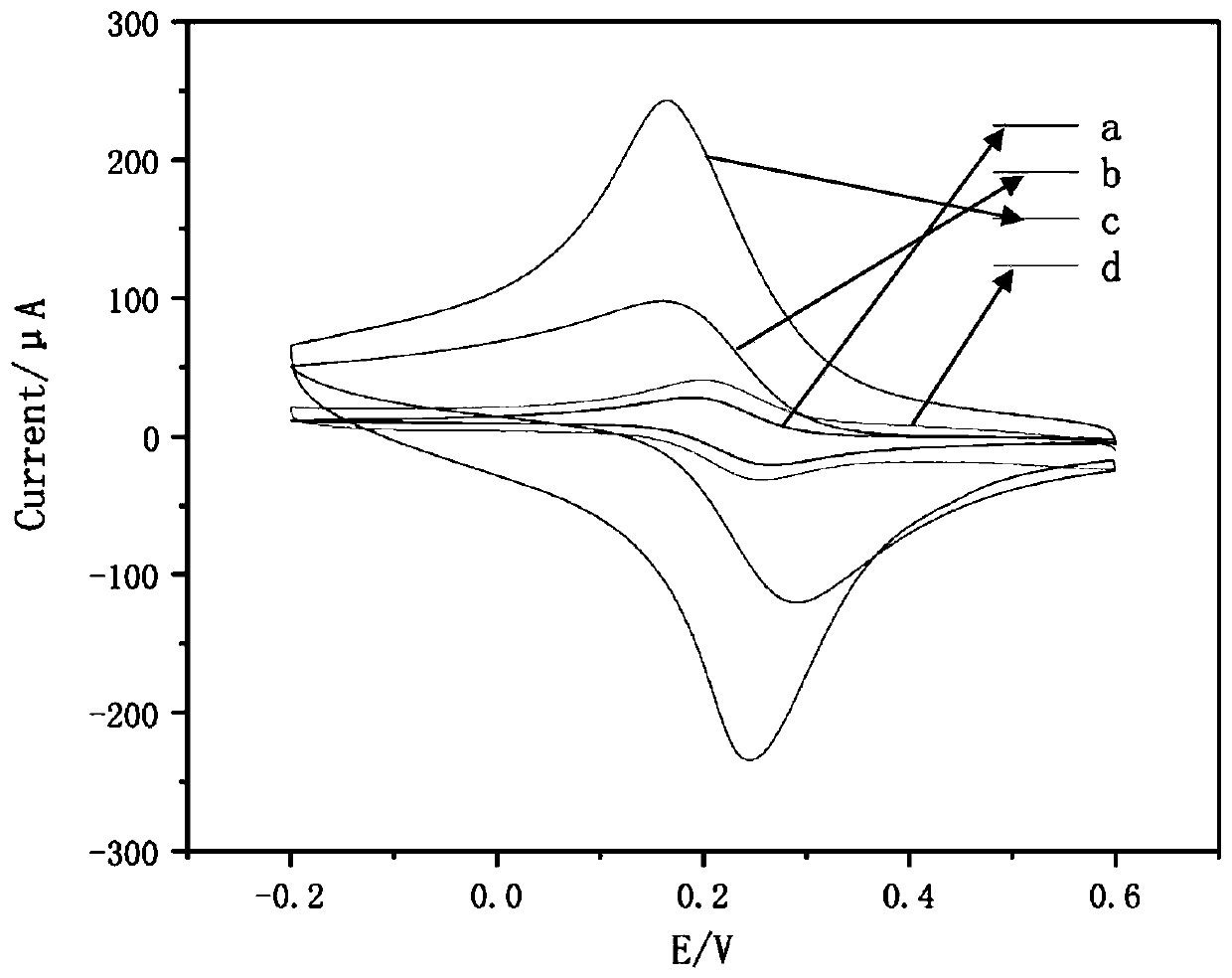Electrochemical sensor for detecting aflatoxin
An aflatoxin and electrochemical technology, applied in the field of biosensors, can solve the problems of poor sensitivity and repeatability of thin-layer chromatography, cumbersome pretreatment steps, and inapplicability for rapid detection, and achieve easy portable and online detection, samples and reagents. The effect of low consumption and large distribution of electroactive sites
- Summary
- Abstract
- Description
- Claims
- Application Information
AI Technical Summary
Problems solved by technology
Method used
Image
Examples
Embodiment 1
[0048] Example 1 Preparation of an electrochemical sensor for detecting aflatoxin based on acetylcholinesterase
[0049] 1. Preparation of electrochemical sensor process steps
[0050] 1) The preparation of Prussian blue-graphene composite: 2ml concentration is that 4mg / ml graphene dispersion is added to 5ml containing 6mg FeCl under room temperature stirring condition 3 ·6H 2 O,8 mg K 3 Fe(CN) 6 , 37mg of KCl in aqueous solution, with HCl to adjust its pH to 1.5. Stir magnetically for 24h. After the mixture was centrifuged and washed several times, it was vacuum-dried at 40° C. for 12 hours to obtain a Prussian blue-graphene composite. Weigh 10 mg of the complex and dissolve it in 0.5 ml of distilled water. The Prussian blue-graphene composite is prepared.
[0051] 2) Preparation of nano-gold-chitosan composite: at first, utilize sodium citrate to reduce chloroauric acid to synthesize nano-gold particles, the synthetic method is as follows: (1) 100ml double distilled w...
Embodiment 2
[0060] Embodiment 2 detects the optimization of the test condition of aflatoxin
[0061] 1. Experimental steps
[0062] 1) pH is worth optimizing
[0063] Different pH values of the test bottom solution have different effects on the activity of acetylcholinesterase, which in turn will affect the sensitivity of the AuNps / CS / PB / GR / SPCE sensor. Therefore, a series of phosphate buffer solutions with pH values were prepared in this experiment. The pH values were 6.0, 6.5, 7.0, 7.5, 8.0, 8.5, and 9.0, respectively, and a series of 1.5mmol / L ATC1 bottom solutions were prepared respectively.
[0064] 2) Optimization of enzyme immobilization amount
[0065] The amount of AChE immobilized on the electrode surface is also one of the important factors affecting the current response of the biosensor. Figure 6 Shown is the AuNps / CS / PB / GR / SPCE sensor after dropping different amounts of acetylcholinesterase, and the electrode without adding acetylcholinesterase to perform cyclic vol...
Embodiment 3
[0075] Embodiment 3 utilizes the application of prepared amperometric acetylcholinesterase sensor
[0076] 1) Inspection of sensor stability
[0077] The stability of the sensor was studied by the inter-group deviation test. The AuNps / CS / PB / GR / SPCE sensor was fabricated on 5 screen-printed electrodes by the same method, and the aflatoxin of 16 μg / mL was determined. The relative deviation 3.8% respectively, indicating that the AuNps / CS / PB / GR / SPCE sensor has good stable reproducibility;
[0078] 2) Linear relationship between aflatoxin concentration and inhibition rate
[0079] A series of concentrations of aflatoxin standard solutions were prepared, and the above acetylcholinesterase sensor was immersed in different concentrations of aflatoxin standard solutions for 14 minutes, and then phosphoric acid containing 1.5mM thioacetylcholine chloride (ATCl) was added to the reaction cell saline buffer solution for cyclic voltammetry scans, Figure 8 Shown are the cyclic voltammet...
PUM
| Property | Measurement | Unit |
|---|---|---|
| diameter | aaaaa | aaaaa |
Abstract
Description
Claims
Application Information
 Login to View More
Login to View More - R&D
- Intellectual Property
- Life Sciences
- Materials
- Tech Scout
- Unparalleled Data Quality
- Higher Quality Content
- 60% Fewer Hallucinations
Browse by: Latest US Patents, China's latest patents, Technical Efficacy Thesaurus, Application Domain, Technology Topic, Popular Technical Reports.
© 2025 PatSnap. All rights reserved.Legal|Privacy policy|Modern Slavery Act Transparency Statement|Sitemap|About US| Contact US: help@patsnap.com



